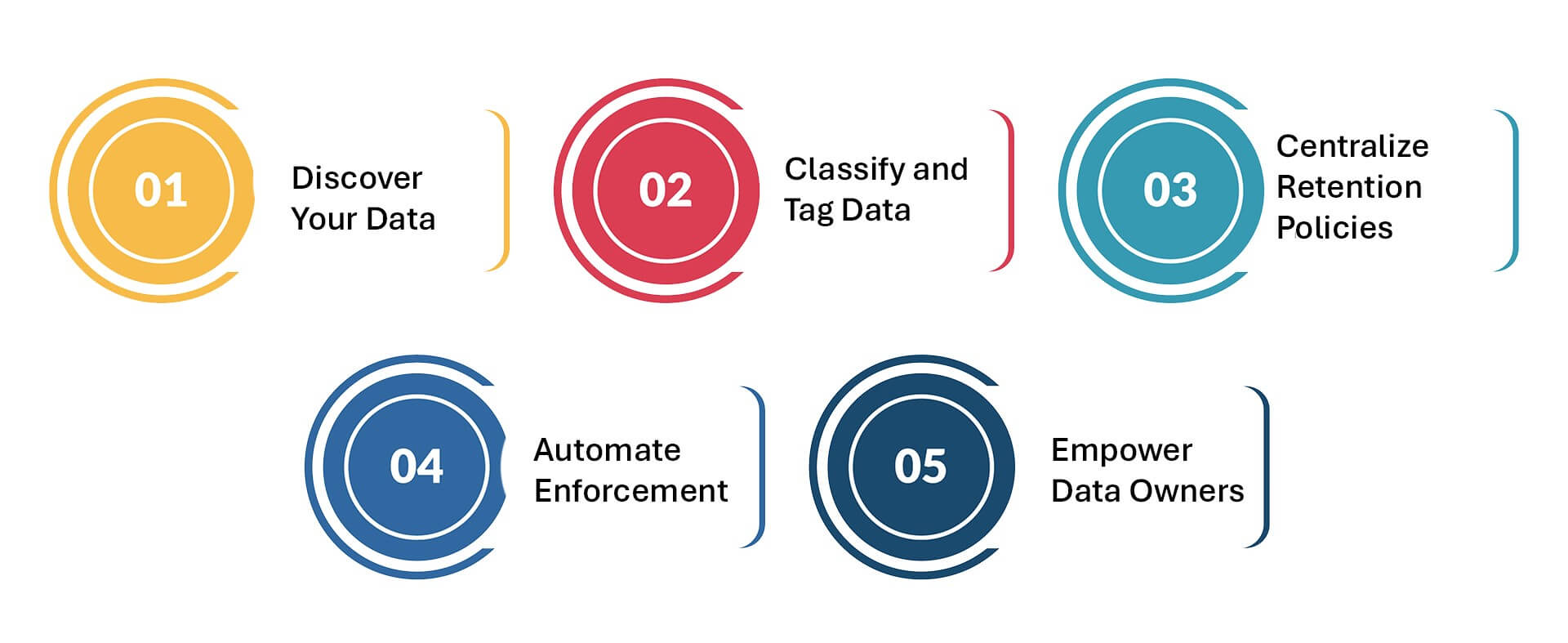In the age of big data, the mantra has long been “more is better.” We’re led to believe that every byte of information might be useful one day, so we stash it all away—just in case. Enterprises build vast records management systems, migrate terabytes to the cloud, and create layers of backups, believing they’re building a fortress of information.
But here’s the uncomfortable truth: the real records retention risk doesn’t always come from not retaining data—it often comes from retaining it for too long.
This isn’t just about storage limits or clutter. Holding onto data beyond its useful life can break record retention requirements, expose you to regulatory risk, and bloat your infrastructure. A modern, resilient strategy is not about “keeping everything forever.” It’s about the art of knowing when to let go—and acting on it.
The Hidden Dangers of Data Over-Retention

More than 80% of enterprise data is unstructured—emails, presentations, spreadsheets, images, documents, messages across Microsoft Teams and Slack, all scattered across on-premises drives, cloud buckets, and archived systems. Often unmanaged and misclassified, this data is kept long past its useful or required retention period.
IDC estimates that nearly 70% of enterprise data holds no business, legal, or regulatory value. And that brings us to the core issue: data over-retention is not a storage strategy—it’s a liability.
Here’s what that liability can look like:
- Regulatory Violations and Fines
Modern privacy regulations don’t just require data to be retained—they also require that it be deleted once it has served its legal or business purpose. Regulations like the GDPR, HIPAA, and India’s DPDP Act are increasingly focused on enforcing data minimization and time-bound retention. Failing to comply with a defined retention period or not following record retention guidelines for businesses can result in serious consequences—financial, operational, and reputational.
- Increased Litigation Risk
In litigation, data becomes discoverable. The more you retain, the more you risk having to produce—and review. That includes all the outdated files and obsolete communications that should have been deleted years ago. Retaining unnecessary documents increases the eDiscovery burden and introduces legal risk, especially when it includes record series no longer relevant or aligned with your record retention and disposition schedule.
- Audit and Breach Exposure
Let’s face it—every file you keep is a file that can be hacked, leaked, or questioned during an audit. Retaining data longer than necessary, especially sensitive or regulated information, increases your breach surface. A targeted attack on a small data set can become a PR and compliance nightmare if old, unmanaged data is exposed. Not following a clear records retention schedule makes this even worse.
- Rising Storage and Infrastructure Costs
Storing data forever costs more than you think. Over-retention consumes valuable primary storage, clogs backup systems, and adds to cloud costs. If you’re not actively enforcing a data retention schedule, you’re paying for capacity you don’t need. Those budget dollars could be spent on innovation instead of storage.
The Root Problem: Invisibility and Disconnection
So why does this happen?
It’s not that companies don’t have a records retention policy. Many have entire PDF documents or templates defining how long to keep each type of record. But there’s a chasm between writing a policy and executing it effectively.
Two big issues cause this disconnect:
- Lack of Visibility Across Unstructured Data
In hybrid environments—where records are spread across legacy NAS, SharePoint, Amazon S3, Teams, Google Drive, and backups—data is often unclassified and unmonitored. Without a comprehensive records management strategy and tools to assess what data exists and whether it has passed its retention period, you’re essentially blind.
- Policy-to-Practice Breakdown
Even when a retention period is clearly defined—say, “retain financial reports for 7 years”—actual enforcement is often manual and inconsistent. Files get left behind, forgotten, or duplicated across environments. You can’t apply record retention guidelines for individuals or departments if you don’t know what’s where or who owns it.
The Way Forward: A Modern Records Retention Strategy

A forward-thinking approach requires more than storing data and hoping for the best. It means embracing a smarter, more strategic model for managing the full lifecycle of data—from creation to defensible deletion.
Here’s how:
Step 1: Discover Your Data
You can’t manage what you can’t see. Start by taking a complete inventory of your unstructured data—across all environments. This discovery phase helps identify what types of records you have, where they reside, and how long they’ve been sitting idle.
Step 2: Classify and Tag Data
Once discovered, data must be classified based on content and sensitivity. Identify files that include PII, PHI, intellectual property, or financial data. Understand whether they’re associated with a particular record series or regulated under state-specific record retention requirements.
Step 3: Centralize Retention Policies
A modern approach includes using a centralized, defensible records retention schedule. This schedule—more than just a PDF—is actionable, aligned with your legal, business, and regulatory mandates, and reflects record retention guidelines for businesses and individuals alike.
Step 4: Automate Enforcement
This is where intelligent records management tools shine. Manual intervention doesn’t scale. Automating retention rules ensures that documents are archived, quarantined, or deleted once their retention period ends—without human error or delay.
Step 5: Empower Data Owners
Records management isn’t just an IT responsibility. Empower department leads and data owners with tools to review, tag, and manage their data based on the policies you’ve defined. This distributed approach helps align practice with policy and promotes accountability across the organization.
The Role of AI and Automation
At the heart of modern records retention is intelligent automation.
AI-enabled records management platforms bring structure to chaos. They can:
- Unify visibility across hybrid storage environments, creating a centralized view of all unstructured data.
- Auto-classify records in real time, making it easier to apply appropriate retention rules.
- Turn policies into executable rules through Policy-as-Code frameworks.
- Generate audit-ready logs for defensibility and regulatory reporting.
- Move data to lower-cost storage tiers based on usage patterns and compliance requirements.
Whether you’re dealing with corporate documentation, sensitive customer files, or legal records, the ability to align your data lifecycle with a record retention schedule ensures that data is always where it should be—and never where it shouldn’t.
Final Word: Letting Go Is the New Keeping
In a world obsessed with collecting data, the real power lies in knowing what to keep, for how long, and when to say goodbye. That’s what turns records management into a strategic advantage. Holding onto everything forever isn’t a failsafe—it’s a risk multiplier.
So, if your organization still measures success by how many terabytes you’ve stored instead of how much you’ve responsibly retired, it’s time for a rethink.
Your bottom line, your compliance posture, and your future agility depend on it.
What’s the biggest records retention challenge your organization is facing? Contact us—we’d love to hear your story and help you solve it.






